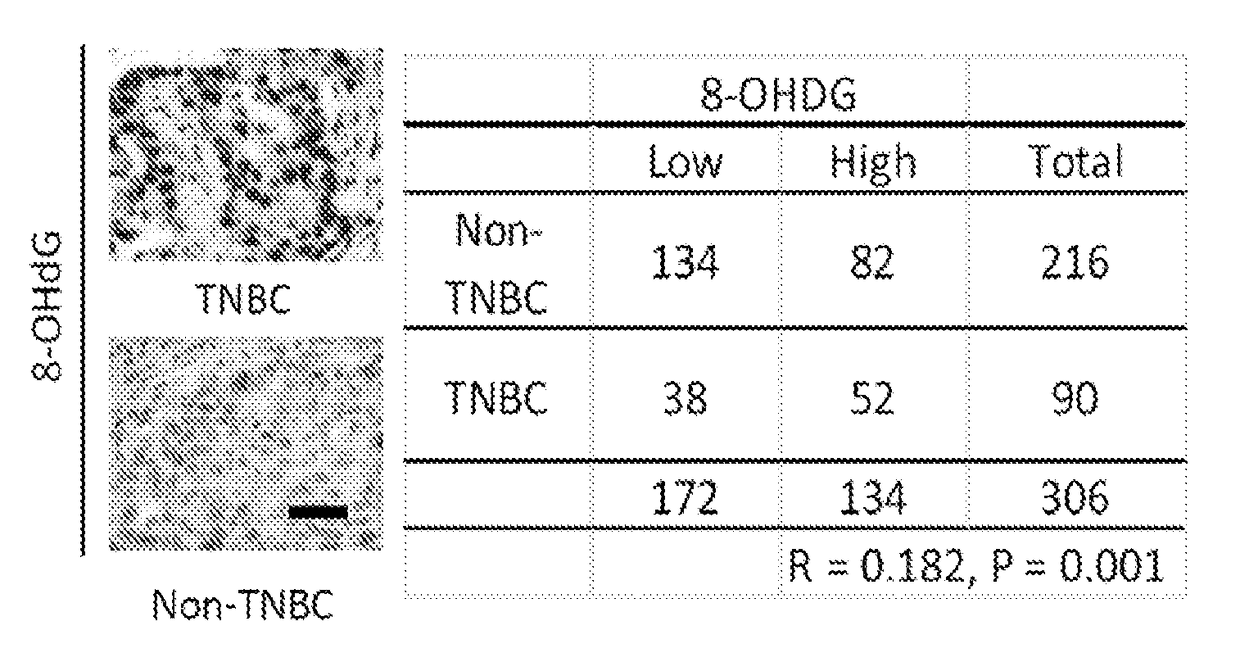Prediction of response to parp inhibitors and combinational therapy targeting c-met and parp1
a parp inhibitor and combination therapy technology, applied in the field of medicine and oncology, can solve the problems of no approved targeted therapy for treating tnbc, no gene therapy approved for tnbc, and genetic instability, and achieve the effect of increasing the response rate of tnbc to parp inhibitors and maximizing the treatment benefit of parp inhibitors
- Summary
- Abstract
- Description
- Claims
- Application Information
AI Technical Summary
Benefits of technology
Problems solved by technology
Method used
Image
Examples
example 1
es Association of c-Met and PARP1
[0129]The levels of 8-hydroxydeoxyguanosine (8-OHdG), a marker for oxidative damaged DNA by ROS, were higher in TNBC than in non-TNBC as shown by IHC staining of the breast cancer tissues microarray (FIG. 1A). Consistent with observations in tumor tissues of breast cancer patients, the 8-OHdG level was also higher in TNBC cell lines than non-TNBC cell lines as seen by immunofluorescence staining and ELISA assay (FIGS. 1B-D). The ROS marker, 2′,7′-dichlorofluorescein (DCF), was also higher in most TNBC cell lines than in non-TNBC cell lines (FIGS. 1E-F and 5). It was then asked whether higher ROS and oxidative DNA damage in TNBC turn on PARP1 activity. Indeed, TNBC cells had higher PARylation than non-TNBC cells (FIG. 1G-H). Together, these results suggest that the TNBC-associated increase in ROS may lead to higher PARP1 activity to repair cellular ROS-induced DNA damage.
[0130]Receptor tyrosine kinases are druggable targets that are commonly overexpre...
example 2
ulates Resistance to PARP Inhibitors
[0131]To determine whether c-Met plays a role in the response to PARP inhibition, cell growth and colony formation ability were examined in the presence of three different PARP inhibitors, olapanib (AZD2281, approved by the U.S. Food and Drug Administration (FDA)), veliparib (ABT-888), and rucaparib (AG014699), which have been evaluated in clinical trials. Indeed, knocking down c-Met rendered MDA-MB-231 cells more sensitive to the PARP inhibitors as indicated by decreased cell viability (FIGS. 2A-C and FIGS. 8A-C). Consistent with knocking down c-Met, inhibition of c-Met by inhibitors, crizotinib, and foretinib also enhanced the sensitivity of cells to PARP inhibitors (FIGS. 2D-E and 8D). In addition, anchorage-independent cell growth was also decreased when c-Met was knocked down (FIGS. 2F and 8E-H). In line with previous findings (Jagadeeswaran et al., 2007), inhibition of c-Met either by shRNAs or small molecular inhibitors all led to the reduc...
example 3
iates PARP1 Functions Through Phosphorylation of PARP1 at Y907
[0134]Next, it was asked whether c-Met activates PARP1 functions. To address this, MDA-MB-231 cells were exposed to H2O2 with or without c-Met knockdown and subjected to a comet assay to evaluate the extent of DNA damage. Cells with c-Met knockdown had higher tail intensity, which is indicative of increased oxidative DNA damage, than the control cells (FIG. 11A). To determine whether the increase in DNA damage was a result of decreased DNA repair, a DNA repair assay was performed in which cells were treated with Hu / Arac (hydroxyurea / 1-fl-D-Arabinofuranosylcytosine) to accumulate H2O2-damaged DNA and then allowed to recover after different time points, at which the percentage of repaired DNA was measured. c-Met knockdown cells were less efficient in DNA repair compared with control cells (FIG. 11B). Results from a luciferase repair assay also demonstrated a reduction in DNA repair function in the absence of c-Met when cell...
PUM
| Property | Measurement | Unit |
|---|---|---|
| time | aaaaa | aaaaa |
| pH | aaaaa | aaaaa |
| pH | aaaaa | aaaaa |
Abstract
Description
Claims
Application Information
 Login to View More
Login to View More - R&D
- Intellectual Property
- Life Sciences
- Materials
- Tech Scout
- Unparalleled Data Quality
- Higher Quality Content
- 60% Fewer Hallucinations
Browse by: Latest US Patents, China's latest patents, Technical Efficacy Thesaurus, Application Domain, Technology Topic, Popular Technical Reports.
© 2025 PatSnap. All rights reserved.Legal|Privacy policy|Modern Slavery Act Transparency Statement|Sitemap|About US| Contact US: help@patsnap.com



